In this article, you’ll learn all about Cutthroat Trout. You’ll learn what they look like, where they have historically been found, and what things affect their existence today.
Cutthroats are the native trout of much of the American West.
One rule of thumb remains emphatically true. You don’t catch Cutthroats in ugly places. Most Cutthroat trout live in the American West’s wilderness, and fishing for them is as much about getting out into some of the last best places left on earth as it is about fishing.
Of the 14 recognized subspecies of native Cutthroat Trout, 2 are extinct, and the other 12 only inhabit a fraction of their original range. When civilization catches up to the places they live in, the fish don’t seem to be able to cope. Cutthroat Trout is worth preserving.
Saving them means saving some of those last best places while doing it in a way that takes into balance the needs of the people that live and make a living in their proximity. That’s not an easy task, but it’s one worthy of the undertaking.
RANGE
Cutthroat Trout is a species of the family Salmonidae native to cold water drainages of the Pacific Ocean, the Atlantic Ocean, and the Great Basin in the western United States. Waters in the Great Basin do not drain to any Ocean but end in sinks and endorheic lakes, “a lake with no outlet.”
Coastal Cutthroat trout are widely distributed along North America’s west coast. Prince William Sound in Alaska is the Northern boundary of their range. They are located as far south as northern California’s Eel River.
The original range of Cutthroat Trout also extended inland to the eastern front range of the Rocky Mountains.
Characteristics
Throughout their native and introduced ranges, cutthroats vary widely in size and coloration. Their coloration ranges from golden to gray to green on the back. Except for the Paiute variety, they are liberally sprinkled with black spots along their sides back, and on their dorsal fin that becomes more numerous towards the tail.
Cutthroats generally have teeth at the base of the tongue and an upper jawbone that extends beyond the eye’s edge. Most have distinctive red, pink, or orange slash marks along the underside of their bottom jaws beside the lower edge of their gill plates. These slash marks are the reason they are given the general designation of “cutthroat.”
At maturity, depending on the habitat, different subspecies range from 6 to 40 inches ”15 to 102 cm” in length. Sea-run coastal cutthroat trout average 2 to 5 pounds. The length and weight of mature inland forms vary widely depending on their particular environment and food availability. Stream-resident fish are much smaller than lake-dwelling populations.
The largest cutthroat subspecies is the Lahontan. These fish average 8 to 9 in (20 to 23 cm) in small streams and 8 to 22 (20 to 56 cm) in larger rivers and lakes. In ideal environments, Lahontans typically weigh 0.25 to 8 pounds (0.11 to 3.63 kg).
In Nevada’s Pyramid Lake, it’s not uncommon for anglers to land twenty-plus pound Lahontan Cutthroat Trout. The documented world record Cutthroat, which incidentally came from Pyramid Lake, was a Lahontan that was 39 in (99 cm) long and weighed 41 pounds (19 kg). There are stories of early settlers in the area catching 60 plus pound Lahontan Cutthroat.
Habitat
Cutthroat trout require cold, clear, well-oxygenated rivers and streams with gravel bottoms to spawn in cold, moderately deep lakes. Healthy stream-side vegetation that holds back erosion and reduces silt load is typical of productive cutthroat trout habitat. In shallow streams, beaver ponds provide refuge during periods of drought and over winter. Most populations stay in freshwater throughout their lives and are known as nonmigratory, stream-resident populations.
Some coastal cutthroats spend a few months out of the year in the Pacific Ocean to feed. They then return to freshwater from fall through early spring to feed on insects and spawn.
Lahontan Cutthroats have evolved to live in the highly alkaline conditions found in the endorheic lakes of the Lahontan Basin.
Some Cutthroat Trout History

Rio Grande cutthroat Trout was first described in 1541 in the Pecos River near present-day Santa Fe, New Mexico, by Spanish conquistadors who were in what is now the southwestern United States searching for gold.
Yellowstone and West Slope
From 1803 through 1806, Captains Meriwether Lewis and William Clark led the Corps of Discovery on an expedition from Pittsburg, Pennsylvania, to the Pacific northwest coast. President Thomas Jefferson commissioned them to explore and map the newly acquired Louisiana Purchase. They were also tasked with finding a practicable route to the Pacific Ocean and establishing an American presence in the Pacific North West before the British or other European nations could.
They were also to identify and catalog any new plant or animal species they came across along the way. They were the first to scientifically classify both the Yellowstone and West slope Cutthroat trout. The Cutthroat Trout Species name is “clarkrii,” in honor of Captain Clark.
Until the 1960s, West Slope and Yellowstone Cutthroats were lumped into one subspecies, “Salmo clarkii lewisii,” lewisii being in honor of captain Lewis. As earlier stated, in the 1960s, biologists separated them into two subgroups. West slope Cutthroats kept the Salmo clarkii lewisii designation while Yellowstone Cutthroats were named Salmo clarkii bouvierii.
Lahontan
In 1844 Captain John C Fremont discovered Pyramid Lake and the Truckee River. He christened the Giant Lahontan Cutthroat trout that were so abundant there, Salmon Trout. The Lahontan Cutthroat and another fish called Cui-ui were so plentiful that the Paiute people living there could make them a major part of their subsistence lifestyle.
Before the arrival of white settlers, the Lahontan Cutthroats of Walker Lake and the Walker River were so abundant that the Paiute people living in the Walker Lake Basin called themselves the Agai-Dicutta Numu. Roughly translated, this means “the Trout eaters people.”
Human-induced habitat degradation wiped out both these massive fisheries. I’ll touch on that more later.
Preservation Challenges
Cutthroat Trout are icons of the undisturbed wilderness of the western United States. When the first white settlers arrived in the west, these fish were abundant in their habitation areas. As the west became civilized, those settlers modified the environment to support human existence. Unfortunately, what is beneficial to human civilization is sometimes antithetical to the benefit of native wildlife. At present, several Cutthroat species are listed as threatened, and two are considered extinct.
Habitat degradation is a huge limiting factor on native Cutthroat populations.
Habitat degradation includes anything that promotes the increase of silt load in stream channels. Unregulated livestock grazing into riparian zones, timbering, road building, and forest fires all can increase the siltification of stream beds.
The building of dams and the diversion of river water for human use are also causes of habitat degradation.
It is naïve, unproductive, and even hypocritical to call for the abolishment of the above practices. The radical environmentalist instinctively calls for radical intervention as long as that intervention does not affect his own way of life or livelihood. If we value these iconic native trout, more consideration needs to be given to balancing their needs with man’s needs.
Competition from introduced species has had a profound negative effect on native Cutthroat Trout populations. Introduced trout and Char species outcompete them for food and available space. In some cases, they view them as prey.
In some cases, introduced Rainbow Trout breed with Cutthroats creating Cuttbows.
Nonnative Cutthroat trout have also been introduced into areas where they can breed with the Cutthroats native to that area. This dilutes the genetic purity of that particular strain.
Cutthroat Trout Sub Species
There are fourteen recognized subspecies of Cutthroat, with two of those being considered extinct.
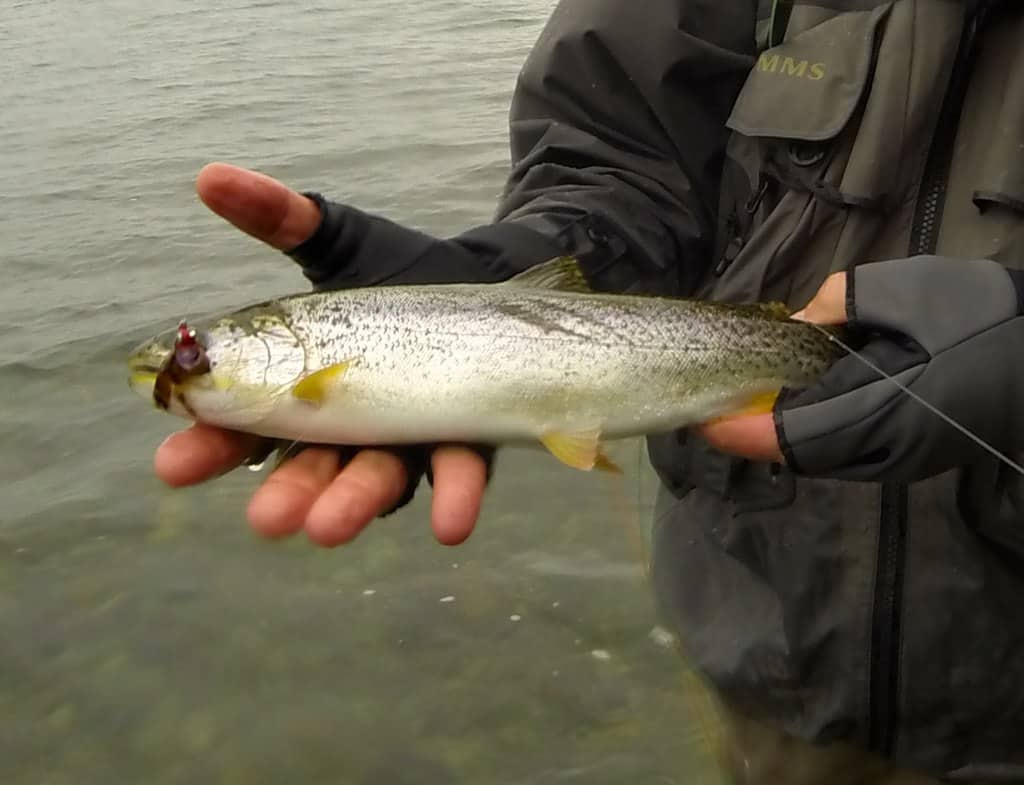
1- Coastal Cutthroat Trout
The Coastal Cutthroat Trout is native to the Pacific coast of North America. Its range extends from Prince William Sound, Alaska, in the north, to the Eel river of Northern California in the south.
You can identify Coastal cutthroats by all their spots. They are blanketed with small to medium-sized, irregularly shaped dark spots when they are in freshwater. When these fish live in the Pacific Ocean, the spots fade away, and their skin takes on a silvery hue.
There are three classifications of Coastal Cutthroats, the classification being dependent upon the environment they exist within. It isn’t a given that an individual fish will remain within the same classification for its life duration. Boundaries between the classifications are fluid.
1-Nonmigratory coastal cutthroat trout: Fish are found in small streams and headwaters of larger rivers. These fish are nonmigratory. On average, these fish grow slower than fish from the other two categories. They’re also smaller at maturity and don’t live as long as migratory forms of Coastal Cutthroat.
2-Freshwater-migratory coastal cutthroat trout: In this classification, fish migrate entirely within freshwater. This includes populations that migrate from large rivers to smaller streams to spawn and populations that inhabit lakes and migrate upstream to spawn in the lake’s inlet or downstream to spawn in the lake’s outlet.
3-Saltwater-migratory coastal cutthroat trout: Juvenile fish migrate from the freshwater areas where they were born to the ocean in the late winter and spring to feed through the summer. They then go back to fresh water in the winter to feed and or spawn. They may or may not return to the ocean in the spring.
2- Alvord Cutthroat Trout
The Alvord Cutthroat was native to Trout and Virgin Creek, which drain into the Alvord Basin of southeastern Oregon and western Nevada. The Alvord Cutthroat Trout are officially declared extinct. The Alvord Cutthroat’s undoing came in the form of Rainbow Trout, which was introduced into Trout and Virgin creeks. Due to hybridization, pure strain Alvord Cutthroats quickly disappeared.
There have been instances cited where genetically pure Alvords were transplanted into other areas, but efforts to locate any existing fish population have proved fruitless so far.

3- Bonneville Cutthroat Trout
Bonneville Cutthroat Trout are native to waters that drain to ancient Lake Bonneville’s basin in northwestern Utah, southwestern Wyoming, southern Idaho, and western Nevada.
Ancient peoples in what would become Utah used Bonneville cutthroat as a primary food source. Early settlers in the Salt Lake and Utah Valleys also relied heavily on Bonneville cutthroat to get them through the first few years. After the pioneers arrived in Utah, they used a lot of native Bonneville cutthroats.
Utah Lake
These fish were big and plentiful in Utah Lake. Records show that they grew up to 40 pounds. Bonneville Cutthroats were so plentiful in Utah Lake In the 1850s that they were fished commercially.
Overfishing was one of Bonneville Cutthroat Trout’s downfalls. In 1931 only one Cutthroat trout was recorded as being caught out of Utah Lake.
Utah lake is a microcosm of what happened to the Bonneville Cutthroat throughout its native range. Wide-spread over-fishing, competition from introduced species, and habitat degradation all played a part in driving these fish to the brink of extinction. A few decades ago, the Bonneville Cutthroat was thought to be extinct and/or genetically compromised in essentially all of its native range.
In 1974, Bonneville Cutthroats was found in Birch Creek in the Deep Creek Mountains of western Utah. An additional population was found in Trout Creek, also in the Deep Creek Mountain Range.
To preserve Bonneville Cutthroat populations that were once thought to be extinct, the Utah Division of Wildlife Resources closed Birch Creek and Trout Creek to fishing. Consequently, the creek’s fish populations rebounded. When Birch and Trout’s creeks reached their carrying capacities of about 1,000 fish per mile, surplus trout were transplanted to other streams on the Deep Creek Mountains’ eastern slopes.
Deep Creek Mountains
Subsequent cooperative projects have been pursued between the State of Utah, private landowners, and the Goshute Tribe to expand the Bonneville Cutthroat’s hold on its former range in the area.
Other isolated Bonneville Cutthroat populations were also found. By 1978, six populations were known to exist in Utah. By the early 1990s, Field investigators from multiple agencies had increased that number to 29. Today, an aggressive recovery effort has yielded around 202 Bonneville cutthroat trout populations that occupy about 2,728 miles of stream in Utah, Idaho, Nevada, and Wyoming.
Here’s an article on Bonneville Cutthroat Trout in Nevada

4- Humboldt Cutthroat Trout
Humboldt Cutthroat Trout are native to the Humboldt Basin in northern Nevada, the Upper Quinn River of Nevada and Oregon, and the Whitehorse Basin in southern Oregon.
They’re most closely related to the Lahontan Cutthroat Trout of northwestern Nevada and Northeastern California.
Humboldt Cutthroats tend to be greenish bronze to copper on the back, transitioning to pale yellow with pink hues sparsely sprinkled with black spots along the sides. They have a faint red stripe along their lateral lines that becomes more pronounced at spawning time. They also have a red cutthroat stripe along their lower jaw.
Man-caused habitat degradation mostly due to livestock grazing and irrigation diversions and competition and hybridization from introduced trout species have been bad for Humboldt Cutthroat populations.
Biologists estimate that these fish once inhabited as much as 2,200 stream miles. Today Humboldt Cutthroats inhabit between 180 and 250 miles of stream habitat. Due to this substantial population decline, they were listed as endangered under the Endangered Species Act in 1969. They were downlisted to threatened in 1975. Recovery efforts are ongoing.

5- Lahontan Cutthroat Trout
The Lahontan Cutthroat is native to the headwaters and tributaries of ancient Lake Lahontan. Lake Lahontan was a giant mega lake in northwestern Nevada, Southeastern Oregon, and northeastern California over 12000 years ago.
Today Lake Lahontan is gone, but its headwaters still exist. Pyramid and Walker Lakes in Nevada are remnants of what was once that giant inland freshwater sea. Cutthroats from the Humboldt River drainage, Quin river drainage, and the White Horse Basin in Southern Oregon are listed as separate subspecies. Still, they are also part of the collective known as Lahontan Cutthroat Trout since they inhabit ancient Lake Lahontan headwaters and are closely related to the Lahontan Cutthroat race.
This section talks about the Lahontan Cutthroat that inhabits the Truckee River, Pyramid Lake, and once inhabited Walker Lake.
Human caused habitat degradation
The discovery of gold in California and silver in northwestern Nevada with the massive influx of settlers that accompanied each was not kind to Fremont’s Salmon Trout. Due to habitat degradation caused by various human activities such as timbering, irrigation, and dam building along the Truckee River, the Pyramid Lake Lahontan Cutthroat Trout was declared extinct in 1943.
That isn’t the end of the story. The descendants of those Paiute Indians that Fremont found on Pyramid Lake’s shores back in 1843 won several lawsuits that returned water to the Truckee River, vital to supporting a viable trout fishery in Pyramid Lake. That still isn’t the end of the story though
In the 1970s, a different strain of Lahontan Cutthroat from Summit Lake in Nevada was introduced into Pyramid Lake. A sport fishery was once again established but, the Summit Lake strain of Lahontan Cutthroat doesn’t live as long or grow nearly as large as the original Pyramid Lake Lahontan Cutthroats. Also, these fish never successfully reproduced in the wild.
Pilot Peak Lahontan Cutthroat Trout
In the late 1970s, fish were discovered in a tiny stream inside the Utah border that researchers believed to be the Pyramid Lake strain of Lahontan Cutthroat Trout. There was no way to genetically prove if they were or were not the same fish.
Now, fast forward to the early 2000s. Biologists compared DNA from the runty little fish found in Utah to samples found in museums of the monsters formerly found in Pyramid Lake. This research proved that giant Pyramid Lake Lahontan Cutthroat Trout was not extinct after all. It’s not known when or why they were stocked there. Nonetheless, they were alive and well in a small stream near Pilot Peak in Utah! In 2006 Pilot Peak strain Lahontan Cutthroats were introduced back into Pyramid Lake.
Since then, they have thrived! Once stocked in the lake’s environment, what is now known as the Pilot Peak strain of Lahontan Cutthroat grows about an inch per month. Twenty-pound fish are not uncommon. Biologists feel that thirty pounders are just around the corner.
6- White Horse Basin Cutthroat Trout
While they are considered a subspecies of Lahontan Cutthroat, genetic evidence proves that White Horse Basin Cutthroat Trout is unique from all other Lahontan Cutthroat strains. They are native to Whitehorse and Willow Creeks, flowing from the Trout Creek Mountains in southeastern Oregon.
These fish have adapted to survive in the conditions found in their desert environment and can withstand short intervals during times of drought when water temperatures become extremely high.

7- Paiute Cutthroat Trout
Paiute Cutthroat is the rarest non-extinct Cutthroat subspecies. They are native only to Silver King Creek on the Sierra Nevada Range’s eastern slope in California. They are believed to be a strain of Lahontan Cutthroat that evolved different characteristics over time due to their extreme isolation.
These fish are purplish in color and differ from other cutthroat subspecies in that they lack most body spots. They grow to a maximum size of 10 inches and weigh up to 1 pound.
Hybridization with introduced Rainbow Trout has been a major downfall to keeping a stable Paiute Cutthroat Trout population. They’re currently listed as threatened.
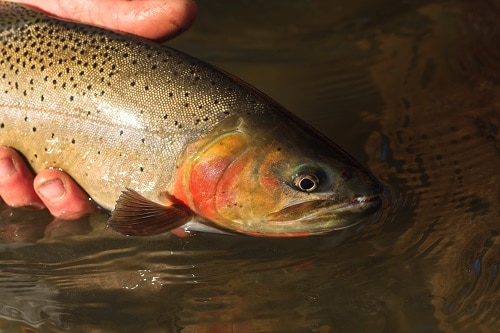
8- Snake River Fine Spotted Cutthroat Trout
Snake River and Yellowstone Cutthroat Trout are genetically indistinguishable. Consequently, Snake Rivers are considered by many to be a variety of Yellowstone Cutthroat. They do have a specific phenotype that sets them apart, though, and is thus considered to be a separate sub-species
Snake River Fine Spotted Cutthroats are profusely sprinkled with fine black spots over the majority of their body. Their lower fins’ coloration is typically more of a deep red or orange color than Yellowstone Cutthroats. In most other ways, they are similar to Yellowstone Cutthroat. These fish can attain lengths of over twenty inches long and weigh more than three pounds.
They are native to the Snake River drainage between Jackson Lake and the Palisades Reservoir in Wyoming.
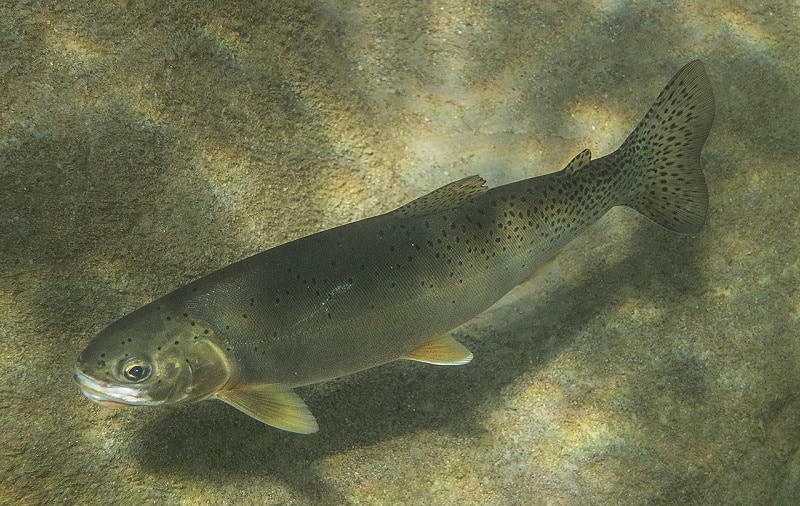
9- West Slope Cutthroat Trout
The West Slope Cutthroat is native to the west slope drainages of the Rocky Mountain Front in Montana and the headwaters of the Missouri River. They’re also in the headwaters of the Saskatchewan River in Canada. Additionally, there are pockets of them in Wyoming, Idaho, and Washington.
West Slope Cutthroat Trout, along with Yellowstone Cutthroat Trout, is Montana’s state fish. They’re also the fish of Lewis and Clark. They were discovered and classified by the Lewis and Clark expedition in the early 1800s. Thus, the scientific name” Oncorhynchus clarkii lewisi.” West Slope Cutthroat Trout and Yellowstone cutthroat Trout were once categorized as the same subspecies. Yellowstone Cutthroat trout have since been reclassified as “Oncorhynchus clarkii bouvieri.”
The following quote is from the Montana Field Guide.-West Slope Cutthroat Trout “It can be difficult to visually distinguish West slope from other cutthroat trout subspecies, but the West slope Cutthroat Trout tends to have more small spots by the tail and none by the pectoral fin, and the fish is more of a silvery or greenish color. The only way to be certain about identification of this subspecies is by genetic testing.”
Threats to West Slope Cutthroat populations include habitat degradation due to human activity, competition for food, and habitat from introduced species. They’re also susceptible to hybridization with Rainbow Trout and Yellowstone Cutthroat Trout.

10- Yellowfin Cutthroat Trout
Yellowfin Cutthroat Trout once inhabited Twin Lakes in the Arkansas River headwaters on the Rocky Mountain Front’s east slope in Colorado.
These fish could weigh up to ten pounds. They disappeared in the early 1900s. This came soon after the introduction of Rainbow Trout to Twin Lakes. They are now considered extinct.
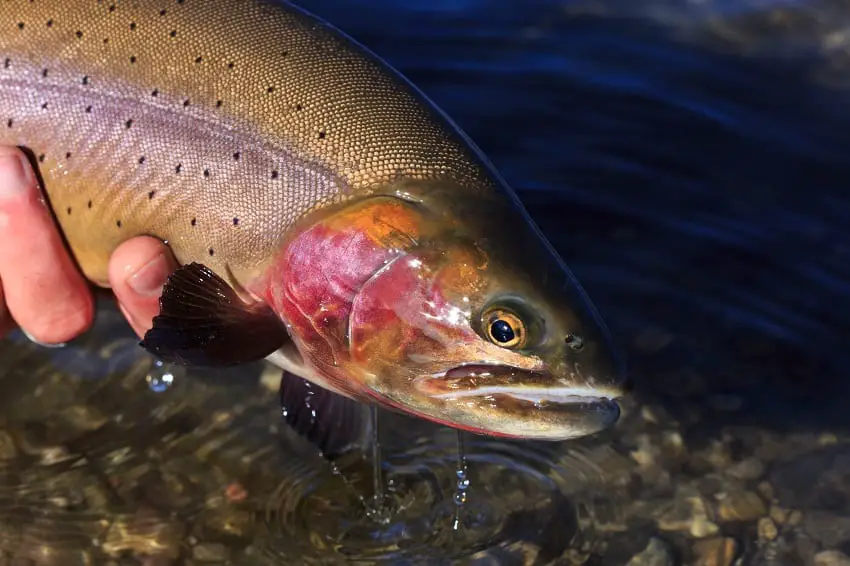
11- Yellowstone Cutthroat Trout
Yellowstone Cutthroats have prominent red slashes on each lower jaw that is common to most Cutthroat Trout. They have medium-large, black spots on their sides that become concentrated toward the tail. Beneath the spots, their body coloration is drab brownish, yellowish, or silvery, with brighter colors likely not present even in mature fish.
Yellowstone Cutthroat Trout is native to much of the Yellowstone River basin, the Snake River Basin, and their respective drainages. The states they are native to are Montana, Wyoming, Idaho, Utah, and Nevada.
Although they are still relatively abundant, Yellowstone Cutthroat Trout populations suffer after their exposure to civilization, just like all other native trout. Stream dwelling Yellowstone Cutthroat currently inhabits around 7,500 stream miles. They originally claimed around 17,400 miles. That’s a 67% decrease.
They are adversely affected by unregulated grazing in riparian areas, streams carrying heavy silt loads due to road building, the seasonal drying up of streams due to irrigation diversions, and the parasite-induced whirling disease. The single greatest challenge these fish face, though, is competition from introduced nonnative species. Introduced Brook, Brown, and Rainbow Trout Compete for habitat. Rainbow Trout are capable of crossbreeding with them, rendering their gene pool impure.
Yellowstone Lake is the strongest population center of lake dwelling Yellowstone Cutthroat Trout. It is now home to a population of Illegally introduced Lake Trout. Lake Trout are fish eaters capable of devouring Yellowstone Cutthroats from Frye size up to sixteen inches long.
Lake Trout will have a devastating effect on Yellowstone Cutthroat Numbers in the lake if left unchecked. Biologists have been gill netting them in known spawning areas to get a handle on the problem.
For More information on Yellowstone Cutthroat Trout, look here for a more in-depth article.
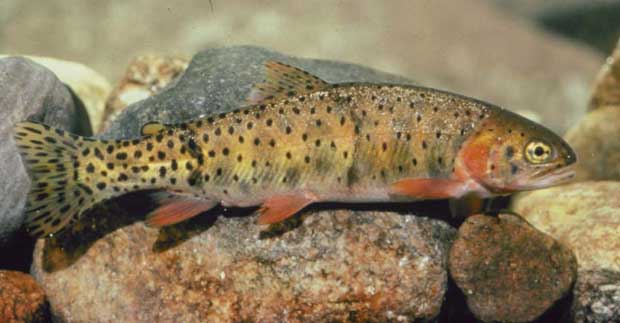
12- Colorado River Cutthroat Trout
Colorado Cutthroats are tan to copper-colored along their back and sides. These fish sport crimson gill plates and slash marks along their lower jaws. A faded crimson also extends along their sides and belly. Colorado Cutthroats are one of the most beautifully colored trout.
The Colorado River Cutthroat’s historical range encompassed most cool water rivers and streams that drain to the Colorado River. This includes waters in Colorado, southern Wyoming, eastern Utah, extreme northwestern New Mexico, and northeastern Arizona. Currently, however, Colorado River Cutthroat trout occupy approximately 16 percent of its historic range.
Like all western native trout, Colorado River Cutthroat populations are adversely affected by many different things. The first one is human-caused habitat degradation. The second is competition from human-introduced trout species.
I know I sound like a broken record. Still, the chief causes of habitat degradation are Livestock grazing in riparian zone areas, water diversion for irrigation projects, and the building of roads.
The larger limiting factor to Colorado Cutthroat trout populations is competition for habitat and crossbreeding with introduced trout species.
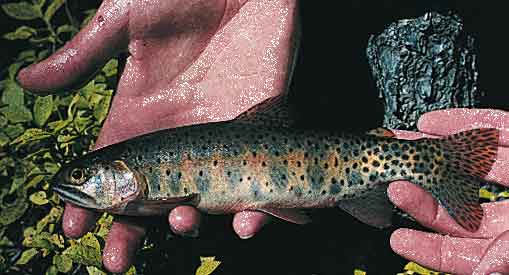
13- Greenback Cutthroat Trout
The Greenback Cutthroat Trout is Colorado’s state fish. It is also the easternmost subspecies of Cutthroat Trout.
They’re native to the Arkansas and South Platte Rivers’ Drainages on the east side of the Rocky Mountains in Colorado. They also lived in a few South Platte tributaries that originate in southeastern Wyoming.
These fish were numerous when the first settlers began arriving on the Rocky Mountain front range. As is the ever-reoccurring theme, though, native trout do not fare well when introduced to civilization. Mine-related pollutants flowing into streams, water diverted for irrigation, livestock grazing in riparian zones, and competition from introduced trout species all took their toll. The Greenback Cutthroat Trout was officially declared extinct in 1937.
People were happy enough with the introduced trout species that easily replaced the native fish. The demise of the Greenback Cutthroat Trout wasn’t a cause for alarm at that time. In the 1960s, an interest in preserving native trout began to sprout forth.
In 1968, Dr. Robert Behnke announced the discovery of a previously unknown population of Greenback Cutthroat Trout.
These fish were collected, and their offspring were reared and restocked in historical Greenback cutthroat territory. State and Federal agencies spent multi-millions of dollars in treating lakes and streams to remove nonnative fish. They then replaced those non-native fish with what scientists believed to be greenback cutthroat trout.
Fast forward to the early 2000s. A student at the University of Colorado/Boulder, studying genetics, discovered a mistake had been made. The fish that had been the object of such a huge restoration project was not greenback cutthroat trout after all. Genetically, they are actually a strain of Colorado River cutthroat.
Researchers discovered a small isolated population in a creek on Pikes Peak’s side after an exhaustive search. Now the experts must start all over again to propagate fish from this small population and restore them to their native habitat.

14- Rio Grande Cutthroat Trout
The Rio Grande Cutthroat Trout live in cool water mountain streams and lakes in the headwaters of the Rio Grande, Pecos, and Canadian rivers in Colorado and New Mexico.
They are the southernmost of the fourteen Cutthroat subspecies. They also happen to be New Mexico’s state fish.
Rio Grande Cutthroat Trout generally have tan to bronze-colored sides, transitioning to more brilliantly colored brass-colored backs. They have dark spots along their sides that are most abundant on and close to the tail. They’re less so further up the body towards the head you go. Most of them display red or orange coloration along their lower flanks. They also have the red slash on each side of the throat that all Cutthroat Trout have.
These Fish primarily inhabit mountain streams. Due to these waters’ non-nutrient dense conditions, these fish generally have a top size of 10 to 12 inches.
Historically it’s the consensus that they inhabited all waters within the Rio Grande, the Pecos, and the Canadian River systems capable of supporting trout. There is also anecdotal evidence that these fish once occurred as far south as Texas.
The Pecos River is a tributary of the Rio Grande. On the other hand, the Canadian runs to the Mississippi and has no communication with the Rio Grande or the Pecos. It is suspected that in some bygone eras, the Canadian and Pecos rivers shared headwaters. This scenario explains the presence of the Rio Grande Cutthroat in the Canadian River drainage.
Rio Grande Cutthroats in the Pecos and Canadian River drainages have been isolated from those in the Rio Grande long enough to possess minor genetic differences.
The Rio Grande Cutthroat only occupies ten percent of its presumed historical range. The same problems plagued all the native western Trout species when they have come in contact with civilization.
Enjoy Your Time Pursuing And Appreciating Cutthroat Trout
They are, after all, swimming around in some of the last best places left on Earth.
While you’re at it, take the time to learn about each subspecies and what it’ll take to preserve them for future generations.
Recent Posts
The only venomous snakes in Washington State are Northern Pacific Rattlesnakes. The Northern Pacific Rattlesnake (Crotalus oreganus oreganus) is a sub-species of the Western Rattlesnake. Anyone...
Skunks are not classified as true hibernators. But they go into a state of torpor when the weather gets cold. Skunks are light sleep hibernators, along with opossums, bears, and raccoons. ...

